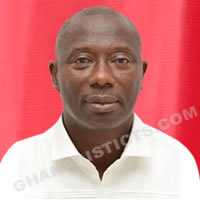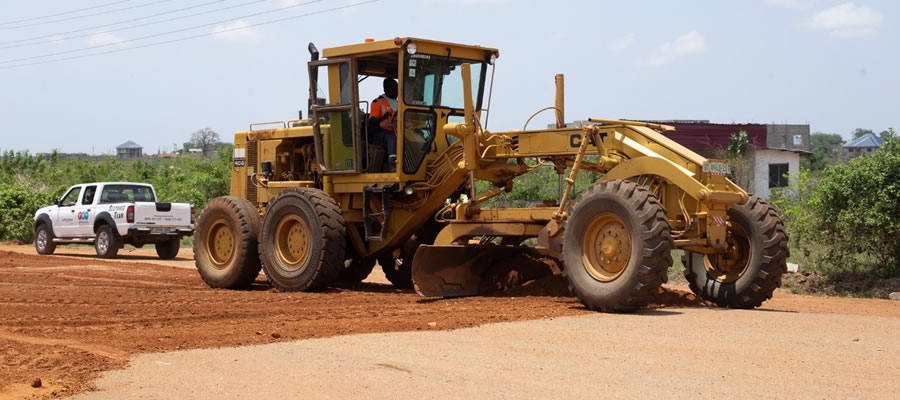

Location
The Kpone Katamanso Municipal Assembly is located in the eastern part of the Greater Accra Region and stretches from the coast to the southern lower slopes of the Akuapim Mountains. It shares boundaries with Shai-Osudoku and Ningo-Prampram District Assemblies on the East, Adentan and Ashaiman Municipal Assemblies, and Tema Metropolitan Assembly on the West, Gulf of Guinea on the South and Akuapim South District Assembly on the North. The Kpone Katamanso Municipal Assembly is about 38 kilometers drive from Accra, the capital city of Ghana and falls on longitude 004’0E and latitude 50 40’ 60N. The total land area of the Municipality is 209sqkm.
The Kpone Katamanso Municipal Assembly (KKMA) was carved out from the Tema Metropolitan Assembly in 2012 with the promulgation of the Legislative Instrument (L.I.) 2031. The Assembly has a membership of 29 made up as follows: (18 elected, 9 appointed, 1 Member of Parliament and 1 Municipal Chief Executive). The Assembly was inaugurated on 28th June 2012 and commenced business on 4th July 2012..
The topography of the Municipality is generally flat and forms part of the coastal plains, ranging from 0m (South) to 35m (North) above sea level. The terrain of the Municipality barely rises up to 65m high. The almost flat nature of the Municipality has made it flood prone and therefore demands a high cost for construction of drainage.
Soil
The soil types in the area are sandy, clayey, humus soils and gravel. Some portions of the land are very rocky. The soils are suitable for farming activities and the major crops grown are cassava, pepper, okro, tomato, maize, onion, carrot, and mango and water melon.
Climate
The Municipality lies in the coastal savannah zone of Ghana. It enjoys a dry equatorial climate with a mean annual rainfall ranging between 730mm to 790mm. The rainy season is usually from April to July (major rainy season) and from September to November (minor rainy season). The highest amount of rain is experienced in May, June and early July. Temperature is relatively high all year round with significant daily and seasonal variations. The annual average temperature range between 25oC and 30oC in the major rainy season while in the minor season the temperature ranges between 27oC and 35oC.
The number of industries and waste generated increases in the Municipality without a corresponding increase in afforestation to absorb excess carbon dioxide generated by these factories. Also, areas that were reserved as green belts are being encroached upon and developed as residential areas. These can lead to negative changes in weather condition and its associated effects such as loss of biodiversity, erratic rainfall pattern etc. This will invariably affect crop production in the Municipality.
Vegetation
The vegetation zones in the Municipality comprise the following: shrub and grassland. The grassland is found in areas like Appolonia, Gbetsile, Santeo, Katamanso, etc where livestock farming is practiced.
Geology
The Precambrian rocks of the Dahomeyan formation underlie the Municipality: metamorphic rocks mainly consisting of granite, gneiss and schist have been probably derived from sedimentary layers. These rocky formations are weathered or decomposed at the surface with a KPONE-KATAMANSO MUNICIPAL VEGETATION thickness not exceeding 12m in the area. Most of the communities in these areas have taken advantage of this and are engaged in stone quarry as a form of employment. Geological resources such as salt deposits exist at Kpoi-Ete.
Natural Environment
The Municipality abounds in lots of natural resources such as lagoons, forest and shrub lands. The Gao and Laaloi lagoons enters the sea at paradise beach and Odii Nyonma beach respectively. The Laaloi lagoon begins from Dawhwenya and stretches to Kpoi-ete. The aquatic resource paves way for dams to be built of which the Sagiana, Atta-laryea-bu, Domebra, Korkortsegbe, Otia-Mensah, Adjensu, Ajensei, Alokpana, Awutu-djor, Fetompuorrya-djor, Teshie Agbmacha-djor, Djormfaa, Butee, Adenkesu Djor,Tsenku Djor, Tsoko-faa, Nii Botswe, Tetteh enyo, Tanbu, Djowulu and the Katamanso Dam are prominent. It serves as a habitat for many flora and fauna notable among them are the Mudfish, tilapia, tortoise etc. Apart from the Domebra (in Zeenu) and the Adjiesu (in Gbestile) which are facing threats of pollution due to unauthorized human activities, the rest of the dams are in fairly good condition and plays a major role in the agricultural businesses of the area. They are usually tapped for irrigating the farms in the area. The Gbetsile dam has been earmarked for the one village one dam project by the central government that is yet to take off.
The Laaloi lagoon sometimes serves as place of pleasure for the community members as well as people from neighbouring towns during holidays. However, these communal natural resources are not being maintained and some of the community members defecate around the area making it unattractive to potential tourists. The Assembly can develop it into a nice tourist site to generate revenue from it.
The only forest in the Municipality is known as the Pinkwai Forest popularly known for the Katamanso war which was fought between the Ga-Dangbes and the Ashantis. The shrub lands are gradually being taken over by estate developers and sand winning activities. The sand winning activities especially needs to be regulated to prevent land degradation which is gradually becoming a menace in the Municipality.
The Built Environment
The built up area of the Municipality is made up of planned communities, and the industrial area. The residential areas (both well planned and squatter settlements) form about 60% of the total land area with industrial and commercial areas making up the remaining 40% of land cover. The squatter settlements are usually found in areas such as Kpone Kokompe, around the Kpone Barrier and parts of Zenu, and the industrial areas. With rapid population increase, the built up areas continue to increase and this has compounded the environmental and sanitation challenges that faces the Municipality.
Some houses have been constructed in waterways, and this together with the proliferation of other unauthorized structures contributes to flooding. This is seen in areas like Zenu, Golf City, Bethlehem, Kokompe and Kpone.
Vegetation cover also continues to be reduced by Estate developers and other related activities. Land that was used for agricultural purposes has been lost to housing development. This situation not only has implication for the environment, but also the livelihoods of farmers who are into crop production.
Climate Change, Biodiversity, Green Economy and Environment
Development in every nation thrives on the environment. This means that you cannot develop without making use of the environment. It is imperative to be cautious of the impact of developmental projects on the natural and built up environment. Development in the Municipality cannot isolate itself from the environment. Hence the use of the environment for development has a serious impact on the climate and green economy.
The Municipality has a lot of environmental concerns; ranging from sanitation issues, pollution of greenhouse gasses that causes climatic change, environmental degradation among several other environmental concerns. The effects of climate change on agriculture in the Kpone- Katamanso Municipality cannot be overemphasized. It is making people lose their livelihood due to flooding/drought and there is therefore the need to come up with measures to mitigate the effects because agriculture plays a key role in the economy of the Municipality.
Climate changes have devastating effect and threaten the future livelihood of the inhabitants of the Municipality. Sea rise is a likely threat to the lives of the inhabitants along the coast. Farming (food security) is inhibited due to intermittent aridity and altered rainfall pattern. In addition, the adverse effect of climate change on women is pronounced (water, health and gender inequality). Sand wining and gravel at the sites in the Municipality degrades the land and affect agriculture activity.
The green economy which deals with environmental sustainability-addresses concerns on environmental depletion which does not compromise on the future generation. The MDG goal 7 addresses environmental sustainability by the year 2015. “UN” member subscribers are entreated to integrate the principle of sustainability into development policies and to reverse the loss of environmental resources. The Municipality’s adherence to sustainability will affect its development in the long term, driving growth of income and jobs, while reducing environmental risk. Contrary, delay in initiating effective mitigation actions will increase the long–term social and economic cost of unsustainable environment. An effective, well-funded strategy is needed to protect the poor and most vulnerable.
Coping strategies:
(a) Rainwater harvesting
(b) Water rationing
(c) Enforcing traditional norms, forbidden days, taboos, bye-laws, etc.
(d) Construction of wells and boreholes
(e) Tree planting programmes and water protection awareness campaign
(f) Replanting of failed farms and trees
Effects of climate change
a) Prolonged inadequate rainfall or droughts
b) Affects the quantity and flow of water in rivers and streams
c) Wells dry up in during the dry season
d) People, especially children and women, spend more time looking for water
e) Water related diseases like bilharzia and diarrhea are often reported
f) Land hardens, develop cracks, soil becomes dry and does not support crops
g) Crop failure due to no rains and altered rainfall pattern
h) Wild fires or bushfires increase, especially from November to March
i) Extreme heat
j) Heat related diseases such as shingles, malaria and other skin debilitations
k) More financial resources spent on medical treatment
l) Wilting and drying of crops
m) General uncomfortable feeling
To this end, some mitigation measures that the Assembly through the Agric Department has put in place in relation to agriculture include:
a) the application of organic manure
b) diversification of crop production
c) promote irrigation farming
d) planting of improved/ resistant varieties
e) tree planting at catchment areas like dams and dug outs
Also, the Assembly have budgeted for climate change mitigation activities to address effects of climate change in the Municipality.
Water Security
About 70% of the population in the Municipality have access to pipe borne water from the Kpong Dam and the Oyibi water scheme. The remaining 30% who do not have access to pipe borne water depend on water tanker services, dams as their source of water. However, it should be noted that not all the 70% population have regular flow of water and therefore rely on private water tanker services due to low pressure during the dry season. Some areas in the Municipality that lack potable water and depend mostly on water tanker services are Katamanso, Kubekro 1&2, part of Zenu and Gbetsile, Santeo, Adigon and Gonten. It should however be noted that in 2015, the district constructed a bore-hole for the residents of Katamanso to have access to clean and portable water but this bore-hole is only serving a part of the community. The Assembly would have to assist these communities by providing them with potable.
In 2004, the Danish International Development Agency (DANIDA) through the Community Water and Sanitation Agency (CWSA) established the Oyibi Water Scheme to provide water for rural communities in and around Oyibi area. It serves a population of over 8,000 located in 6 communities: Mansah Bar, Oyibi Township, Kpone Seduase, Old Saasabi, New Saasabi and Oyibi Estates. The communities were previously 9 but it has reduced to 6 as mentioned above because these communities (Valley View University, Good News Theological College, and Malejor) are now served by Ghana Water Company Limited.
Natural and Man Made Disasters
Kpone Katamanso Municipality over the years suffered series of casualties and loss of properties as a result of natural and manmade disasters namely flood, fire outbreaks, disease epidemics, wind storms, droughts etc. The impact of the disaster hinders development in that properties are destroyed; this in effect calls for planning to ensure that the Municipality is made resilient to these shocks and stresses that trigger the disasters.
Presently, flooding is noted as one of the predominant disaster in the Municipality which is mostly engineered by series of human activities ranging from building on the water ways, dumping refuses on water way resulting in shocked gutters, inadequate drainage system etc. Community 25, Gulf City, Gulf Estate and Zenu are the highly affected communities. Currently the NADMO department at the Municipal Assembly embarks on preventive measures such as educating the public on proper waste disposal, not building on water ways etc. to manage such occurrences. The Assembly is also doing it best by de-silting choked gutters to avert this disaster. The Assembly should also enforce development control to prevent people building on water ways. One major challenge facing the Assembly is inadequate logistics to avert this disaster.
Natural Resource Utilization
The Municipality is endowed with natural resources like a lagoon, forest reserves, land, sand and gravels. These resources are utilized for economic gains. Land is use for building and agricultural production. Sand and gravels are wined for construction purposes, forest reserves at Katamanso and Valley View cannot be under estimated. The Pinkwai forest at Katamanso is a historical one that is not fully utilized as it is evident that people have encroached on it. Archeological findings by the University of Ghana, Legon indicates that, the forest can be developed into a tourist site that would fetch revenue for the Municipality and the country as a whole. The Assembly should therefore collaborate with the tourism ministry to develop the forest. The sand winning activities especially needs to be regulated to prevent land degradation which is gradually becoming a menace in the Municipality.
Also in existence is the sea, which people fish from as a source of their livelihood and it also serves as a place of pleasure (beach) for the people and neighboring towns during holidays. The Assembly can develop it into a nice resort to generate revenue from it.
Date Created : 4/25/2023 12:00:00 AM












 facebook
facebook
 twitter
twitter
 Youtube
Youtube
 +233 593 831 280
+233 593 831 280 0800 430 430
0800 430 430 GPS: GE-231-4383
GPS: GE-231-4383 info@ghanadistricts.com
info@ghanadistricts.com Box GP1044, Accra, Ghana
Box GP1044, Accra, Ghana